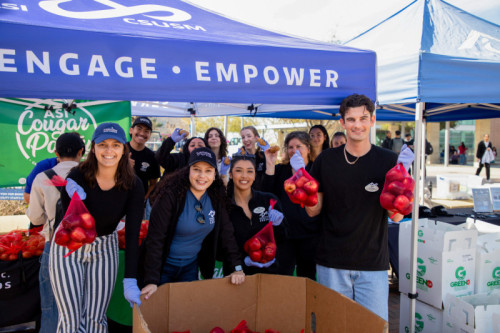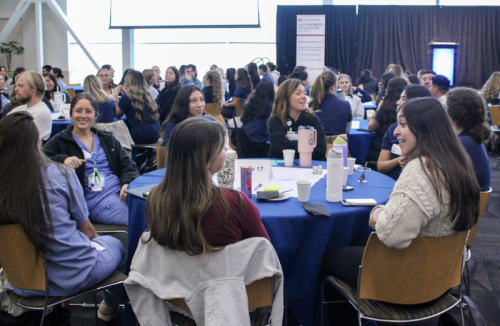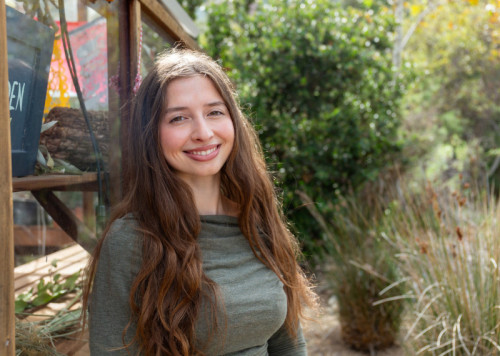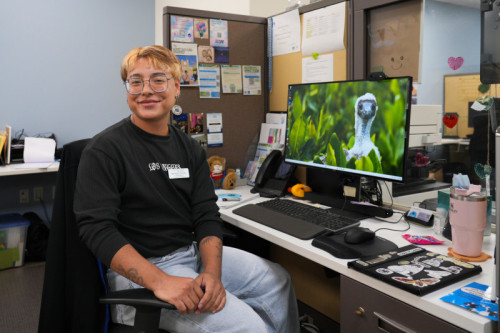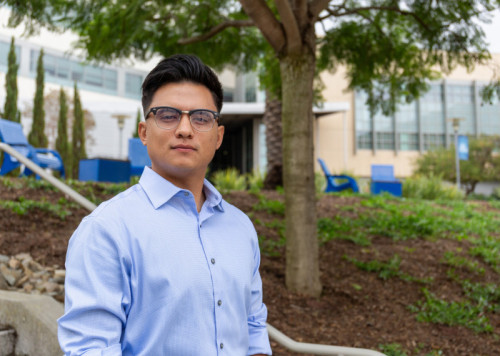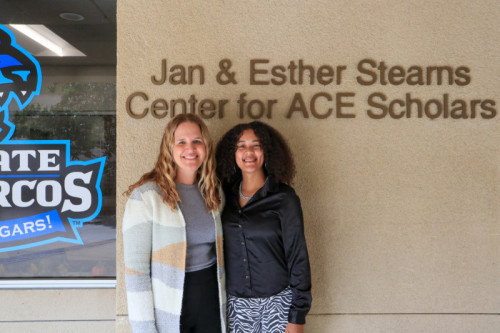CSUSM Helping Students Amid CalFresh Disruptions
12
November
2025
|
11:10 AM
America/Los_Angeles
"; items += "
"; items += "
"; items += "
" + val['title'] + "
"; if(val['subtitle']){ items += "
" + val['subtitle'] + "
"; } items += "
"; if ((val['showpublishdate'] !== 0 && showPublishDateHeadlineSetting) || showPublishCityHeadlineSetting) { items += '
'; if (val['publishcity'] && showPublishCityHeadlineSetting) { items += '
' + val['publishcity'] + '
'; } if (val['showpublishdate'] !== 0 && showPublishDateHeadlineSetting) { items += "
"; items += "
" + date_month + "
"; items += "
" + date_day + "
,"; items += "
" + date_year + "
"; items += '
'; items += ' | '; items += '' + val['publish_time'] + ''; items += 'America/Los_Angeles'; items += '
'; items += '
'; } items += '
'; } items += "
" + val['message'] + "
"; items += "
Read more
"; items += "
"; items += ""; items += tags_items; items += multimedia_count; items += "
Latest Newsroom
- Grant Helps Expand Interprofessional EducationWhen Tania Chambers was growing up, she often found herself helping her parents navigate new systems, serving as an interpreter, advocate and problem-solver. “From a young age, I helped my family assimilate into our new environment, filling in gaps wherever I was needed as a first-generation Mexican American.” said Chambers, now a Master of Social Work (MSW) student at Cal State San Marcos. “I became their translator, doctor, lawyer and social worker. These experiences shaped why I want to do this work.” She carried that sense of purpose into every role she has served – including preschool teacher, nanny and YMCA educator – and she saw firsthand how communication gaps between parents and schools can affect a child’s success. “That made me want to be part of the solution,” she said. “I want to help families and children feel supported.” Now in graduate school – something that once felt out of reach as the first in her family to attend college – Chambers recently took part in an innovative Interprofessional Education (IPE) event hosted by the CSU Shiley Haynes Institute for Palliative Care, which is part of a larger palliative care initiative funded by the Hearst Foundations. Palliative care brings together a team of health professionals to provide holistic treatment for individuals with serious illnesses. IPE focuses on training students to work together in this collaborative model. Designed by CSUSM faculty from multiple disciplines, CSUSM’s IPE program places students from nursing, kinesiology, speech-language pathology and social work together to analyze a case study and develop a comprehensive plan of care. The goal is to help students think collaboratively while gaining an authentic understanding of what teamwork looks like in real clinical settings. “Graduate school can feel siloed since we focus on our own programs,” Chambers said. “This event brings students from multiple disciplines together under one roof to learn from each other and realize how much stronger we are when we collaborate.” In this year’s exercise, Chambers’ team worked on a family-centered case study involving a medically complex 8-year-old boy living with his grandparents. “These cases remind us that families don’t exist in isolation,” she said. “When a child is struggling, it’s not just on the grandparents or the teacher. There’s a whole network of people who can help. Our job is to strengthen that network.” “Students will be expected to collaborate with other professions when they enter practice,” said Katie Robinson, assistant professor of nursing. “But as with every other practice competency, we have to teach them why, show them how and guide them through practicing it themselves. And now that we've worked out such an effective IPE model, it's exciting to think about expanding across the campus – and beyond.” Since spring 2023, the institute has hosted five immersive IPE days, with participation now reaching 150–200 students across the College of Education, Health and Human Services. “Alumni from previous events have shared how this event helped shape their transition into the workforce,” said Lorene Ibbestson, a social work lecturer. “It gave them confidence in their professional abilities and a deeper appreciation for how collaboration across disciplines can create meaningful change.” Now, thanks to a generous $200,000 grant from the Hearst Foundations, CSUSM’s IPE program will continue to grow, with plans to: launch a new IPE event in spring 2026 focused on health policy, including students from psychology, sociology and political science; build a similar IPE model at Fresno State and ultimately other CSU campuses; explore cross-campus collaborations with UC San Diego medical students and Clinical Pastoral Education programs. For students like Chambers, these simulated experiences are invaluable in helping them prepare for meaningful careers. For CSUSM, the Hearst Foundations’ generous support not only strengthens IPE but also moves the university closer to its “Blueprint for the Future” campaign goal to raise $200 million in philanthropy and research funding. Media Contact Brian Hiro, Communications Specialist bhiro@csusm.edu | Office: 760-750-7306
- Media Studies Student Co-Produces Stories for PBS ProgramSitting in her homeroom class during her first year at Westview High School, Roury Fitzpatrick was captivated by the morning newscast produced by her school. She hadn't watched the news much growing up, but it was then that she decided she wanted to pursue broadcast journalism. Fitzpatrick, a second-year media studies student at Cal State San Marcos, has had a passion for writing ever since she was young, creating short stories and pretending she was a New York Times bestselling author. When she became interested in broadcast journalism in high school, she convinced her parents to let her change her elective and she joined Westview's broadcasting class. Her passion instantly ignited. As a high school sophomore, she learned about PBS News Student Reporting Labs (SRL). Fitzpatrick and a few of her classmates helped produce a podcast segment for SRL about teen mental health and high schoolers’ plans after graduating. This inspired Fitzpatrick to create her own podcast. By her junior year, she and her classmates had created their high school’s first podcast, “Wolverine Pause.” It was there that Fitzpatrick interviewed many people, including Fox 5 San Diego weather anchor and reporter Megan Healy. Fitzpatrick has enjoyed every aspect of her journey in broadcast journalism, from conducting interviews to filming, editing and being behind the scenes. She loved the experience as an anchor for her school’s newscast but thought that it was too scripted at times. Fitzpatrick prefers to take a more authentic route, reporting on the scene or searching out individuals to interview in their fields rather than reading off a teleprompter. “I really love interviewing people because that’s when you get that one-on-one connection and you learn the most about them,” Fitzpatrick said. “But I also do like being behind the camera and editing because I feel that's when you see the magic of it all coming together.” After working with SRL on the podcast segment and experiencing the support and mentorship from members of PBS as a high school student, Fitzpatrick decided to apply for PBS News' College Climate Reporting Fellows program as she was preparing to attend CSUSM. After a highly competitive application process in which she had to create a pitch on a climate issue, Fitzpatrick was one of 10 students across the nation selected for the program, joining students from schools including Cornell, Penn and USC. Fitzpatrick co-produced two stories focused on climate issues. The first story came during the SRL’s summer academy trip to Washington, D.C., where she had the opportunity to meet PBS News reporters, ask questions and gather advice about broadcast journalism. The story Fitzpatrick worked on was about Vihaan Mathur, then a 19-year-old climate activist attending UC Berkeley. The story focused on his work combating climate issues, donating to local schools and writing a children’s book about climate change. Fitzpatrick and her team came up with interview questions and shared editing responsibilities. When it was time for filming, Fitzpatrick conducted the interview and recorded the voiceover. Sharing roles with her teammates allowed Fitzpatrick to experience every aspect of creating and producing a news story. The second story was more hands-on. Fitzpatrick was assigned to a group with other SRL members to come up with another story on environmental issues. Her team focused on the language barrier between Spanish and English speakers, and how this makes discussing climate issues more difficult. Highlighting a USC newsletter called “Sustainability Sin Fronteras,” which aims to inform Los Angeles’ Spanish-speaking communities about climate issues, Fitzpatrick’s group interviewed the newsletter’s co-founder, Mayte Abrica. They also interviewed Miguel Ordeñana, the senior manager of community science at the Natural History Museum, which works to bring climate education to L.A. residents. Fitzpatrick and her group spent three days in L.A., brainstorming interview questions, dividing work duties and filming through pouring rain to piece together their story. “There was a lot of rain, we were cold, we were wet, and we had to protect these very nice cameras as we hiked through muddy trails,” Fitzpatrick said. “We were just happy we got through it. It was such a great experience.” Working with SRL and co-producing stories has provided Fitzpatrick with much knowledge and experience as she continues on her journey pursuing broadcast journalism. She loves exploring new topics of research and enjoys the connections she forms with the people she interviews. In the future, she hopes to continue her work with PBS or branch out to other news outlets focused on making change. “I want to tell stories about important issues like war, politics or underrepresented communities,” Fitzpatrick said. “I want to tell stories that have substance to them, stories that matter, where people will turn on the news and feel they need to listen.” Media Contact Eric Breier, Interim Assistant Director of Editorial and External Affairs ebreier@csusm.edu | Office: 760-750-7314
- Founding Faculty Brooks and Marion Reid Champion Student SuccessAs a student-athlete competing in cross country and track and field, Renton McGregor spends most of the year practicing and competing. “On top of training up to three hours a day, my major in algorithmic mathematics is very demanding and leaves little time to hold a job,” McGregor said. “I’m grateful for Brooks and Marion Reid’s support and hope to pay it forward someday, especially in math or athletics.” McGregor's appreciation of the Reids comes from being the recipient of both the Reid Athletic Scholarship and the K. Brooks and Marion Reid Student Achievement Award in Discrete Mathematics. These scholarships are just two of the many ways that the Reids have contributed to Cal State San Marcos over the years. Founding faculty members Brooks and Marion Reid have been champions of student success since CSUSM’s earliest days. Brooks, a mathematics professor emeritus, and Marion, the university’s founding dean of Kellogg Library and now dean emerita, have contributed to initiatives across campus, from academics and research to athletics. Brooks serves on the College of Science, Technology, Engineering, and Mathematics (CSTEM) Advisory Council, staying connected to students like McGregor. "It was exciting to be part of CSUSM from the very beginning,” the Reids said. “The library and mathematics have always been close to our hearts, and we’re proud of how the university has flourished over the years. We had fulfilling careers here, and giving back is a way to honor that legacy and help future generations thrive.” In addition to scholarships and mathematics awards, the couple supports the annual Reid Lecture Series, which invites the campus and local community to experience the beauty of mathematics through continued support for programs like the Mathematical Association of America Institutional Membership, the Putnam Mathematics Competition and the San Marcos Informal Mathematics Colloquium. Thanks to the generosity of donors like Brooks and Marion Reid, CSUSM students have the resources to thrive both academically and personally. Their gifts also contribute to the university’s $200 million “Blueprint for the Future” campaign. Media Contact Eric Breier, Interim Assistant Director of Editorial and External Affairs ebreier@csusm.edu | Office: 760-750-7314
- How One Student Transformed Challenges Into ChangeWhen Sol Haro first attended Cal State San Marcos, he felt isolated. Not because of the school – Haro was an active student and involved in campus clubs – but because of a struggle with his identity. As a Mexican American child of a single parent from a low-income household, he felt a level of pressure to find a place where he thought he belonged. This pressure was amplified by Haro’s identity as a transgender man. He felt alone on campus – othered – because he rarely saw his identity reflected around him. “I didn’t see myself in my peers or professors,” Haro said. “I always tell people I’m a triple threat because I’m brown, I came from poverty and I’m trans. A lot of things have happened in my life, so it's hard to find people who relate to me without disclosing all those things.” Haro graduated last spring with a degree in social sciences, and he now works on campus as a basic needs assistant for the Cougar Care Network. The impact of his work on campus earned him the President’s Student Champion Award for Inclusive Excellence and Diversity this year, and he was honored as the winner at the All Peoples Luncheon on Oct. 23. “Every human being has a right to basic needs, and we should not have to suffer to acquire them,” Haro said during his acceptance speech. By his senior year at CSUSM, Haro realized that what was blocking him from connecting with others was the internal shame he carried as a transgender man. With that in mind, he not only began working on self-acceptance but also sought to be a representation of transgender people in higher education that he longed to see. Last academic year, Haro learned about an opening for a civic engagement ambassador through Service Learning and Civic Engagement. He was drawn in by the office’s advocacy and decided to apply. In his application, he stated that while he is committed to neutrality, his passion is in helping those from underrepresented communities. Soon after becoming an ambassador, Haro began creating a comprehensive and easy-to-understand CalFresh guide for CSUSM students. After going through the challenging and confusing process of applying for CalFresh as a transgender man, Haro used inspiration from his mother to help motivate him to push for a change. “My mom was like, ‘If you don’t like something, then do something about it. No one’s gonna do it for you,’ ” Haro said. The guide is a tool to help all students, but it also highlights issues that transgender students seeking basic needs might encounter, such as what to do when their preferred name doesn’t match their legal name. This was not only a way for Haro to help other students on campus, but also a tool for self-empowerment. “I wanted to create this guide for every student, because getting basic needs is what you deserve. It shouldn’t be so difficult,” Haro said. While his guide focuses on the experiences of transgender, undocumented and mixed-status students, it is for everyone, and Haro encourages all students to apply for CalFresh. “More than half of our students probably qualify for CalFresh, and they’re not doing it because they either don’t know what it is or they have some shame around it,” Haro said. “But if you need that help, there’s no shame in receiving it. You don’t need to suffer for your basic needs.” Breaking the stigma around public assistance programs like CalFresh was also one of Haro’s goals with the CalFresh guide. He saw the shame his mother felt in using programs like CalFresh, Section 8 and Medi-Cal. That shame was amplified by how people reacted when his mom pulled out her benefits card at the grocery store. He said he doesn’t want to see other people struggle the way his mother did just to fulfill their basic needs. “Your physical health, your mental health, food impacts both of those,” he said. “Statistics show that when you have a lack of basic needs, you’re not showing up to class and your grades are dropping. How are you supposed to thrive in school and get your degree if all you’re thinking about is how hungry you are?” Haro has found that seeking assistance can be empowering rather than bringing shame. Creating the guide wasn’t easy. The CalFresh application contains technical language that can be hard for some to interpret. It required cross-referencing documents, taking notes while completing his own application and interviews, and spending hours on research. Every conversation Haro had with a CalFresh representative during this process became a valuable tool to help students. “I wanted the guide to be empowering for people,” Haro said. “Yes, the process is difficult, but once you get the benefits, it’s totally worth it.” Along with the CalFresh guide, Haro has also collaborated with various university departments and student organizations to raise awareness about social justice, voting rights and public policy issues. In 2024, he won the Innovation Hub’s Social Innovation Challenge for his proposal to redesign CSUSM’s commuter hub into a lounge focused on students’ comfort and basic needs. Last year, Haro also contributed artwork that centered on transgender joy and the normalization of transgender identities on campus. The picture, which is on display in the University Student Union, features Haro shirtless, three months after his top surgery. Haro described being open about his transness as “so incredibly scary but so empowering” and “filled with self-love.” As Haro continues his work with the Cougar Care Network, he’s thinking beyond the campus community. What began as a way to navigate his own challenges is now opening doors for others, a step toward lasting change built on lived experience and compassion. “This is representation,” Haro said. “I’m happy, I’m thriving and I’m filled with joy because of who I am.” Media Contact Eric Breier, Interim Assistant Director of Editorial and External Affairs ebreier@csusm.edu | Office: 760-750-7314
- 'Accidental Archivist' Helps Mexican Communities Learn Their HistoryFernando Amador likes to call himself an accidental archivist. Long before he was an assistant professor of history at Cal State San Marcos, Amador was a doctoral student at New York’s Stony Brook University who was doing field work for his dissertation in Mexico. Hoping to comb through the historical archive of the people of Temacapulin, a small town northeast of Guadalajara, he was surprised to learn that they didn’t have one. What they had was thousands of documents piled haphazardly into boxes, all too vulnerable to environmental damage in the event of, say, a flood. Helping to organize the town’s historical record wasn’t part of Amador’s dissertation, but his conscience wouldn’t allow him to return to New York with the papers in such disarray. So he gave himself a crash course in archival studies – which traditionally is more the domain of librarians – and, with the aid of some volunteers from the community, he led an effort in 2022 to whip the archive into shape. During the three months that Amador was in Temacapulin, word of his project spread to neighboring towns. It just so happened that the Indigenous community of San Juan de la Laguna (La Laguna for short) was in the midst of an effort to organize its own historical documents. The people behind it invited Amador to town, and he discovered that this project involved almost twice as many documents (nearly 20,000), stretching back more than a century earlier, to the late 1600s. “When I saw that this project was a different beast compared to the first one,” Amador said, “I knew we needed more resources and more help.” After a hiatus of a few years – during which he finished his dissertation, earned his Ph.D. from Stony Brook and was hired by CSUSM – Amador finally found himself in position to revisit the La Laguna archive. Last spring, he received a $15,000 grant from the Endangered Archives Programme of the British Library, the largest library in the world and the home of such storied pieces as the original Magna Carta. Over the summer, Amador spent two weeks in La Laguna, and the funding not only paid for his trip, but allowed him to purchase laptops and hire and train five members of the community as full-time workers on the 10-week project. “I never imagined I’d end up in this field, but it truly offers incredible opportunities,” he said. “I get to meet new people and develop skills in an area where, surprisingly, historians often know nothing about – archives. You’d think that’s odd, like chemists not learning about the equipment in their own labs. Now that I’m doing this work, I realize just how striking that gap is between what historians do and the archival side of their profession.” Amador streamlined and accelerated a process that had progressed in fits and starts since his initial visit to La Laguna three years earlier. In helping gather the materials, he found that many of them were stored in unfavorable conditions, such as sacks, cardboard boxes and bound together with string. Many also were marked with water stains. As the group surveyed and created an inventory of the documents, they encountered samples both mundane (countless tax receipts) and captivating. One example was a paper record of a legal battle in the early 20th century between a town resident and an immigrant from Lebanon. “How did a man from Lebanon end up in this little town?” Amador said. “That whole story sounds fascinating. Discovering history through these documents is, in a way, truly thrilling.” Beyond just the work itself, the biggest challenge that Amador faced was gaining the trust of an Indigenous community that traditionally has had a fraught relationship with the local government and the outside world at large. “With me coming from the United States, people wondered, ‘What are his priorities? Why is he here helping us? What’s in it for him?’ ” he said. “It really came down to open communication – reassuring them that I’m doing this because I love the work and involving them in the process as much as possible.” As the grant-funded initiative wraps up this fall, Amador is considering a return to La Laguna in January to review the finished product in person. And as the domino effect continues, the second project might lead to a third one. Another nearby Indigenous community heard about the work Amador led in La Laguna and requested his support for its archival project, which features more digitized material instead of old, yellowing papers. For that one, which remains in the preliminary stages, he is coordinating with classically trained archivists, namely Sean Visintainer and Jennifer Ho of the CSUSM University Library. He’s also talking with Visintainer and Ho about the possibility of introducing and teaching a history course in archival studies. “I really did stumble into this type of work. I still am even hesitant to call myself an archivist,” Amador said. “I'm learning so much, and there's still so much for me to learn. But it does seem like this is where my career is headed – bringing archival studies and history together in some way.” Media Contact Brian Hiro, Communications Specialist bhiro@csusm.edu | Office: 760-750-7306
- Kinesiology Student's Inspiring Journey from Foster Care to GraduationSometimes even the smallest things can be taken for granted. Many students never have had to worry about affording a meal or squeezing in hours of sleep between their work and school schedules, but that’s not the case for Alexus Foster. Alexus was in and out of the foster care system from the time she was 2 years old. She has lived in countless states and attended 17 different schools. However, with the help of Cal State San Marcos’ ACE Scholars Services program, she is graduating this winter with a bachelor’s degree in kinesiology and a minor in dance. “ACE has had a really big impact on me,” Alexus said, “and for that I'm very grateful.” Alexus always knew she wanted to pursue higher education because she believed it would help her avoid the challenges that her mother faced. Pregnant at 15 years old, Alexus’ mother struggled to raise a child. After her mom was kicked out of Alexus’ grandmother’s house, Alexus was sent to New York to live with her great-grandfather. Her mother booked a return flight to California, and Alexus’ childhood was on a new course. Growing up, Alexus experienced the hardships of persistent custody battles and court-mandated counseling therapy. She was constantly moving among different households and family members. Alexus is 29 years old and the oldest of six siblings (the youngest is 15). She was 16 when her siblings entered the foster care system for the first time. She hoped to shield them from the reality of foster care. But Alexus and her siblings were apart for almost a year, which was one of the hardest times of her life. Alexus and her siblings have always had a strong bond, celebrating every holiday together at their grandparents’ house as children. “I love my siblings, and I just want to be the best big sister they could have. If they ever need anything, they can call me,” Alexus said. As complicated as Alexus’ life was, additional struggles began to arise when she became an adult. After she moved out of her mom’s house at 19, trying to complete her degree while managing two jobs to afford her rent became a strenuous task. Alexus was attending Riverside Community College when she learned about ACE Scholars Services. It’s a program that would soon change her life for the better. ACE Scholars Services helps former foster youth pursue higher education by providing services and support systems. ACE knows that helping foster youth earn a degree provides them with the tools and self-determination they need to succeed in life. That has been the case for Alexus. Alexus worked the overnight shift at the Ontario airport, ending her shift at 7 a.m., then driving from Rancho Cucamonga for her hour-plus commute to campus. When she hadn’t slept all night, ACE provided her a space to get rest during the day. When she didn’t have enough money to afford food or school supplies, ACE was there. When her car broke down, ACE was there. In October 2024, Alexus lost her job and was evicted, marking the start of a difficult time. But ACE was once again there to help. “The support that I get from ACE, everything that I've been able to get through in my life is because ACE has always helped me, especially Leigh,” Alexus said. Leigh Quijada has been the director of ACE Scholars Services for the last two years after previously working with the program for 13 years as a counselor. She has played a huge role in Alexus’ life by not only guiding her but helping her get through every obstacle she has faced. “Persistent” and “resilient” are the two words Quijada uses to describe Alexus. “I think Alexus might be the only student I’ve had who has been through it all and overcome everything," Quijada said. Quijada has been there for Alexus since the start of her journey at CSUSM and has watched her grow. When Alexus was put on academic probation last year because she had to prioritize going to work to pay her bills over attending class, Quijada did everything in her power to help Alexus get re-enrolled. “She is probably one of the biggest people in my life,” Alexus said. “I wouldn’t be getting my bachelor's without Leigh; she’s definitely my rock.” After the difficult years Alexus endured as a foster child, she is graduating this winter and moving to Texas to begin a master’s program in kinesiology. She has played sports since she was young and hopes to continue her love for that field as an athletic trainer for professional athletes. “People don't know what I've been through to get to this point,” Alexus said. “It's going to be a very big accomplishment.” Media Contact Eric Breier, Interim Assistant Director of Editorial and External Affairs ebreier@csusm.edu | Office: 760-750-7314



